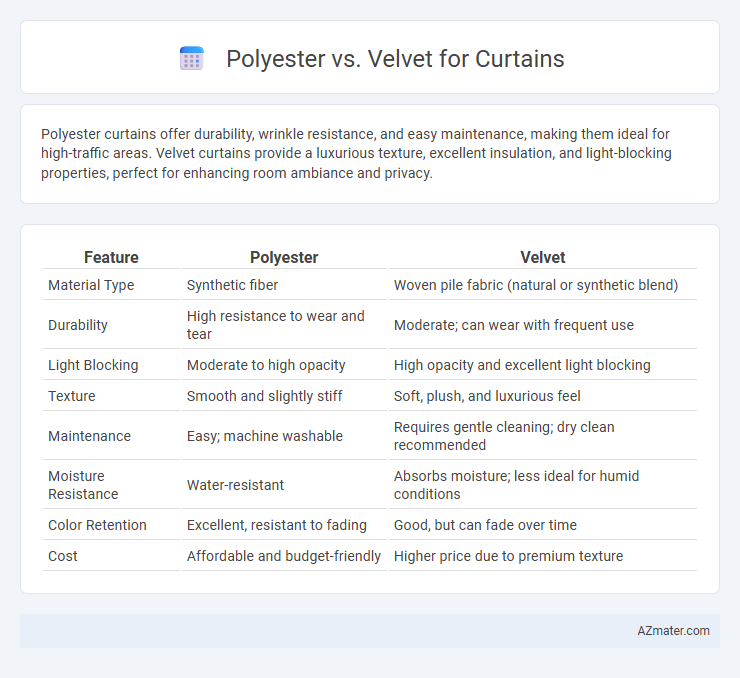Polyester curtains offer durability, wrinkle resistance, and easy maintenance, making them ideal for high-traffic areas. Velvet curtains provide a luxurious texture, excellent insulation, and light-blocking properties, perfect for enhancing room ambiance and privacy.
Table of Comparison
| Feature | Polyester | Velvet |
|---|---|---|
| Material Type | Synthetic fiber | Woven pile fabric (natural or synthetic blend) |
| Durability | High resistance to wear and tear | Moderate; can wear with frequent use |
| Light Blocking | Moderate to high opacity | High opacity and excellent light blocking |
| Texture | Smooth and slightly stiff | Soft, plush, and luxurious feel |
| Maintenance | Easy; machine washable | Requires gentle cleaning; dry clean recommended |
| Moisture Resistance | Water-resistant | Absorbs moisture; less ideal for humid conditions |
| Color Retention | Excellent, resistant to fading | Good, but can fade over time |
| Cost | Affordable and budget-friendly | Higher price due to premium texture |
Introduction: Polyester vs Velvet Curtains
Polyester curtains offer durability, stain resistance, and ease of maintenance, making them ideal for high-traffic areas and modern interiors. Velvet curtains provide a luxurious, textured appearance with excellent light-blocking and sound-insulating properties, suited for elegant and cozy spaces. Choosing between polyester and velvet depends on the desired aesthetic, functionality, and room environment.
Material Overview: Polyester Curtains
Polyester curtains offer durability, resistance to wrinkles, fading, and shrinking, making them ideal for long-lasting window treatments. This synthetic fabric is lightweight yet strong, providing easy maintenance and excellent color retention in various lighting conditions. Polyester's moisture-resistant properties also contribute to mildew prevention, enhancing its suitability for diverse environments.
Material Overview: Velvet Curtains
Velvet curtains are crafted from densely woven fibers, typically made of cotton, silk, or synthetic blends, creating a soft, plush texture ideal for luxurious window treatments. The material's heavy weight provides excellent insulation and light-blocking properties, making velvet a preferred choice for privacy and energy efficiency. Velvet's rich texture and depth of color enhance room aesthetics, offering a sophisticated, elegant appearance compared to the more utilitarian, lightweight polyester curtain fabrics.
Aesthetic Appeal: Comparing Looks and Texture
Polyester curtains offer a smooth, uniform texture with a slight sheen that enhances modern and minimalist interior designs, providing durability and easy maintenance. Velvet curtains present a rich, plush texture with a deep, luxurious appearance that adds elegance and warmth, ideal for classical or opulent decor styles. The choice between polyester and velvet depends on the desired aesthetic impact, with polyester favoring sleek simplicity and velvet delivering tactile richness and visual depth.
Durability and Longevity
Polyester curtains exhibit exceptional durability due to their resistance to stretching, shrinking, and wrinkling, making them ideal for high-traffic areas and frequent use. Velvet curtains, though luxurious and heavy, are more prone to wear over time, especially if exposed to direct sunlight or frequent handling, potentially leading to fading and fabric deterioration. The synthetic composition of polyester ensures longer lifespan and easier maintenance compared to the more delicate nature of velvet fabrics.
Maintenance and Cleaning Requirements
Polyester curtains offer easy maintenance with their wrinkle resistance and ability to be machine washed or wiped clean, making them ideal for busy households. Velvet curtains require more delicate care, typically needing professional dry cleaning or gentle hand washing to maintain their soft texture and rich appearance. While polyester resists fading and shrinking, velvet demands careful handling to prevent damage from moisture and abrasion.
Light Blocking and Insulation Properties
Polyester curtains typically offer moderate light blocking and insulation, making them suitable for general use but less effective in extreme temperature control or complete blackout needs. Velvet curtains provide superior light blocking due to their dense, heavy fabric structure, enhancing room darkening for better sleep and privacy. Their thick pile also improves insulation by trapping heat, making velvet an excellent choice for energy efficiency in both hot and cold climates.
Cost Comparison
Polyester curtains are generally more cost-effective than velvet due to lower production costs and synthetic fiber composition, making them ideal for budget-conscious consumers. Velvet curtains, made from woven natural or synthetic fibers, tend to have higher prices reflecting their luxurious texture and heavier weight. Choosing polyester offers affordability and durability, while velvet commands a premium for elegance and richness in window treatments.
Best Use Cases for Polyester and Velvet Curtains
Polyester curtains excel in durability, moisture resistance, and easy maintenance, making them ideal for high-traffic areas such as kitchens and living rooms where frequent cleaning is necessary. Velvet curtains, known for their luxurious texture and excellent insulation properties, are best suited for bedrooms and formal living spaces to enhance warmth and create a sophisticated ambiance. Selecting polyester is advantageous for budget-friendly, practical window treatments, while velvet offers premium style and superior light-blocking capabilities.
Conclusion: Choosing the Right Curtain Material
Polyester curtains offer durability, easy maintenance, and resistance to wrinkles, making them ideal for high-traffic areas and budgets. Velvet provides luxurious texture, superior insulation, and elegant draping, perfect for formal settings or rooms requiring sound absorption. Selecting between polyester and velvet hinges on balancing practical needs with aesthetic preferences to optimize room ambiance and functionality.

Infographic: Polyester vs Velvet for Curtain
 azmater.com
azmater.com